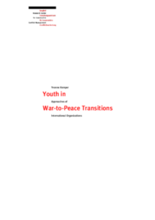This study deals with youth in war-to-peace transitions and the response of international organizations to them. While youth’s relevance for societal transformation is a long-acknowledged fact, their large numbers and potential roles in conflict have recently caused organizations to consider them a target group for peace and development programs. Reflecting on this process, this study thus assesses the difficulties in conceptualizing the role of youth in peace-building processes on the one hand and the concrete efforts of international organizations to integrate them into their policies and programs on the other. For this purpose, it explores four guiding questions: First, what approaches have international organizations developed regarding youth? Second, on which assumptions about youth and their role in violent conflicts are they based? Third, how do the different approaches affect program development, and, fourth, are they are compatible?
One of the obstacles in targeting youth is finding a common definition for them. While the United Nations (UN) defines them as people between the ages of 15 and 24, youth are, in reality, a very heterogeneous group. According to this study, youth is a transitional state between childhood and adulthood and is highly dependent on the socio-cultural environment. The situation of violent armed conflict exacerbates the problems of finding a common definition because it forces children to assume adult roles and functions.
Indeed, a large and growing part of combatants in protracted armed conflicts are youth. Since there is no legal framework for this group, however, demobilization and reintegration programs have largely neglected them in practice. Neither small children nor mature adults, international organizations have been torn between a desire to protect them and allowing for their meaningful participation. In contrast to armed groups, which regularly offer youth an income, an occupation, status, identity and the 'excitement' of violence, most DRPs fail to appeal to older children and young adults. But the failure to (re)integrate youth into civil structures cannot only put the peace-building process at jeopardy but also deprives these war-affected societies of a potential driving force for peace and development.
In order to explain the various responses of international organizations towards youth in conflict contexts, specifically regarding demobilization and reintegration, this study developed three ideal typical approaches: (1) a rights-based approach, (2) an economic approach, and (3) a socio-political approach. The rightsbased approach is based on the UN Convention on the Rights of the Child and has so far confined the work of international organizations regarding youth under 18 years. The economic approach views youth as decision-makers in the marketplace, who respond to supply and demand in pursuit of their interests. The socio-political approach regards youth’s self-perception and their relationship to civil society as crucial for the peace-building process. After outlining their basic ideas on a theoretical level, this study examines two exemplatory demobilization and reintegration programs for each approach to determine their practical value for postconflict peace building.
Accordingly, each approach possesses distinct strengths and weaknesses which are ultimately derived from the different roles they assign to youth in peace and conflict. The strengths of the rights-based approach therefore lie in the preventive phase, the advocacy function and the strengthening of community responsibility. The economic approach, on the other hand, is most effective in the short-term because it can deliver immediate results to young beneficiaries and lure them away from armed forces. The socio-political approach fosters long-term reconciliation by countering the marginalization of young people through their integration into societal structures; it can best account for youth’s gender-related identity because it is based on their participation. As a result of these different qualities, this study concludes that a holistic approach is needed in order for international organizations to profit from their distinct advantages.
All approaches should converge in their common objective to create an enabling environment for youth in post-conflict situations: by protecting them from forced recruitment, giving them a job perspective, furthering their personal development, and asking for their opinion and action. In fact, legal, economic, and socio-political dimensions are all necessary features of war-to-peace transitions. In order to make all three approaches compatible, the challenge is to adapt them to youth. Moreover, international organizations have to share a common perception of youth and to coordinate their policies and programs, putting youth’s concerns before the organization's confined interests. By consolidating and systemizing experiences with youth in war-to-peace transitions, this study hopes to contribute to this endeavor.
©Berghof Research Center for Constructive Conflict Management

